Add this eBook to your basket to receive access to all 172 records. Our indexes include entries for the spelling pitcairn. In the period you have requested, we have the following 172 records (displaying 161 to 170): These sample scans are from the original record. You will get scans of the full pages or articles where the surname you searched for has been found. Your web browser may prevent the sample windows from opening; in this case please change your browser settings to allow pop-up windows from this site. Officers of the British Army and of the Indian Army
(1934)
The Half-Yearly Army List, issued By Authority, 30 June 1934, lists all officers in active service at that date, and this list was evidence of the status and rank of the officers contained in it. The entries are set out as a gradation list, by rank, from field-marshals to lieutenants, and within each rank in order of seniority at that rank. Each officer's name (surname first, in capitals, then christian name and present rank (with date of achieving that rank) and regiment &c. are given, for convenience, in bold type, with any national decorations in italics after the name. Each entry also gives date of birth, number of days service in the ranks, dates of service in each rank of officer, particular offices and postings (with dates) and, where appropriate, a summary of war service, and medals. For all but the oldest of the officers then serving, the war service details are for the Great War (1914-1921), and campaigns in Iraq, Waziristan, and the North West Frontier of India. War services are not given in this edition for Indian Army officers, except in that their entries are preceded by a crossed swords symbol where they have seen war service in a theatre of war overseas. After the gradation list of officers, there is a section for the Royal Malta Artillery; and then (pages 1152 to 1185) warrant officers - staff or garrison serjeant-majors, educational serjeant-majors, serjeant-major (physical training and educational) instructors, regimental serjeant-majors (and corporal-majors, farrier-serjeant majors, master gunners, assistant instructors in gunnery, experimental serjeant-majors, artillery clerks, farrier-serjeant-majors, artificer serjeant-majors, clerks of works, mechanist, superintending clerks, draughtsmen, 1st class staff serjeant-majors, transport, supply, conductors, sub-conductors, armourers, armament artificers, headmasters, schoolmasters, marine gunners, and bandmasters. The section for the Royal Army Chaplains' Department lists all chaplains (1st to 3rd class); and that for Queen Alexandra's Imperial Military Nursing Service has all matrons, sisters and staff nurses. The lists of nurses do not give date of birth: all are unmarried. The book concludes with the Yeomen of the Guard, the Honourable Company of Gentlemen-at-Arms, and the King's Body Guard for Scotland, in each case giving name (surname and initials, not christian names), honours, name of late regiment, and date of appointment.
| Sample scan, click to enlarge

| British Civil Servants
(1935)
The British Imperial Calendar lists civil servants in Britain, arranged according to the organizational structure of the state, and shows their qualifications and salaries. | Sample scan, click to enlarge
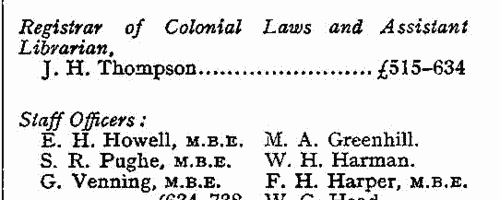
| Boys entering Aldenham School
(1938)
Aldenham School in Hertfordshire is a public school originating as an Elizabethan grammar school. The Aldenham School Register was first published in 1898, but this tenth edition, by R. J. Evans, and published in 1969, comprised only living old boys who had entered the school from 1900 onwards, together with those who had entered the school before 1900 and who had responded to a questionnaire. There is thus a general presumption that all the boys mentioned were alive in 1969. The boys are listed alphabetically by surname under the term in which they entered the school. Full name is given, in bold, surname first. Then an abbreviation indicating their house (B, Beevor's; K, Kennedy's; M, McGill's; P, Paull's; SH, School House); the period of stay at the school; address as of 1969; father's name, occupation and residence (where the father had also studied at the school, his name is given in capitals with the year of his entry); brief details of any achievements at the school (particularly at sports); and the briefest of details of subsequent career. | Sample scan, click to enlarge
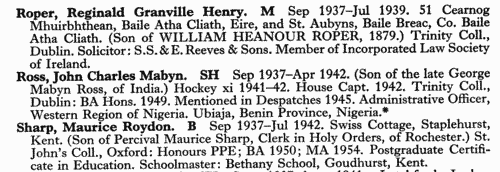
| Freemasons in Coromandel chapter, Madras
(1938)
List of members of the Ancient and Accepted Rite for England, Wales, the Dominions and Dependencies of the British Crown, January 1938. An asterisk before a name indicates a P. M. W. S. of the Chapter; the number 30 indicates a Grand Elected Knight, K. H., 30th Degree; 31, Grand Inspector Inquisitor Commander, 31st Degree; 32, Sublime Prince of the Royal Secret, 32nd Degree. | Sample scan, click to enlarge
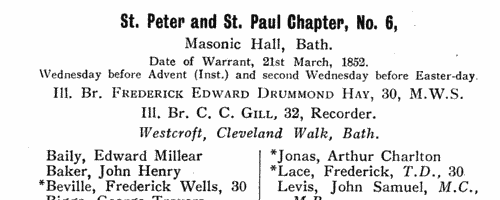
| Chartered Electrical Engineers (A. M. I. E. E.)
(1939)
The Institution of Electrical Engineers was founded in 1871 under the name of The Society of Telegraph Engineers, and incorporated by royal charter in 1921. The list of members, corrected to 1 September 1939, gives the names and addresses of the various grades of members. Members (M. I. E. E.) and Associate Members (A. M. I. E. E.) were entitled to describe themselves as Chartered Electrical Engineers. Then there are the Associates (Associate I. E. E.), Companions (Companion I. E. E.), Graduates (Graduate I. E. E.) and Students (Student I. E. E.). The names are given in bold, surname first; before each name is the year of attaining that grade; and for the higher grades the year of each lower grade is also given, e. g. (G. 1931). | Sample scan, click to enlarge

| London Telephone Subscribers
(1939)
The London telephone directory lists subscribers alphabetically by surname and then by christian name or initials, with their postal address and telephone number. This is the L to Z directory issued in May 1939, but also contains some names from earlier in the alphabet, for instance in the separate section for midwives. The London telephone districts comprised not only the city centre, but also the very extensive suburbs in the Home Counties (Essex, Kent, Surrey and Middlesex). | Sample scan, click to enlarge

| British Civil Servants
(1940)
The British Imperial Calendar lists civil servants in Britain, arranged according to the organizational structure of the state, and shows their qualifications and salaries. | Sample scan, click to enlarge
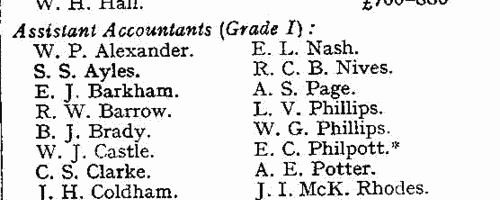
| Boys entering Marlborough College
(1941)
The public school at Marlborough in Wiltshire was founded in 1843. In 1952 this, 9th, edition of the college register was published, being a revision by L. Warwick James of the 8th edition (of 1936): but for the years before 1936 it does not merely repeat the 8th edition, because Warwick James was able to correct the 19th-century entries with information from newly-discovered letters and books from 1843 to 1853, and the school lists from 1844 onwards. The roll is arranged by year, and within each year by term of entrance, and then alphabetically by surname within each term. Each boy is assigned a number within the year: then his name is given, surname first, and, in brackets, his house. The houses within the college were called B1, B2, B3, C1, C2 and C3, and the Lower School (L Sch); the out college houses were Preshute, Priory, Cotton, Hermitage, Littlefield, Barton Hill, Summerfield and Upcot. Then there is given the boy's father's name (surname and initials) and address (at entrance), the boy's date of birth (b) and month of leaving (l). Where the boy represented the school at Rugby football (XV) or cricket (XI), in the rifle corps (VIII, or RC XI), that is indicated. There is a brief summary of achievements in later life, and, where known, and date of death or (in italics) address as in 1952. | Sample scan, click to enlarge
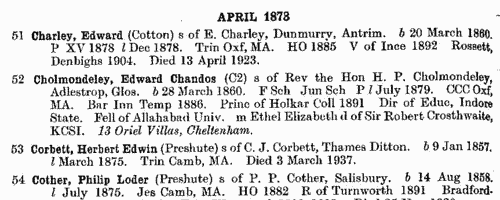
| Chartered Electrical Engineers (M. I. E. E. and A. M. I. E. E.)
(1951)
The Institution of Electrical Engineers was founded in 1871 under the name of The Society of Telegraph Engineers, and incorporated by royal charter in 1921. This list of members, corrected to 2 July 1951, gives the names and addresses of the Members (M. I. E. E.) and Associate Members (A. M. I. E. E.), all of whom were entitled to describe themselves as Chartered Electrical Engineers. The names are given in bold, surname first; before each name is the year of attaining the grade of Associate Member (AM) or Member (M); and, before the address, the year of reaching each lower grade is also given, e. g. (G. 1931), G standing for Graduate, S for Student. Where the engineer was also a member of one of the institution's specialized sections, this abbreviation is given, in bold: M, Measurements Section; R, Radio Section; S, Supply Section; U, Utilization Section. | Sample scan, click to enlarge

| British Civil Servants
(1953)
The British Imperial Calendar lists civil servants in Britain, arranged according to the organizational structure of the state, and shows their qualifications and salaries. | Sample scan, click to enlarge
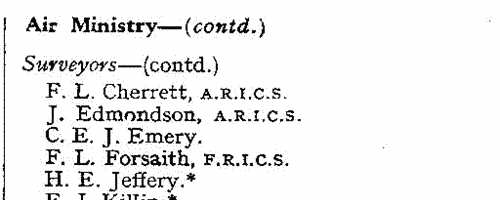
|
Research your ancestry, family history, genealogy and one-name study by direct access to original records and archives indexed by surname.
|











